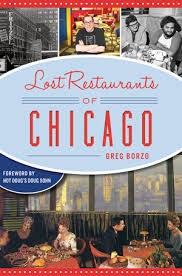Book Review: Lost Restaurants of Chicago
 Sunday, December 30, 2018 at 3:29PM
Sunday, December 30, 2018 at 3:29PM  Lost Restaurants of Chicago. Greg Borzo. The History Press, December 3, 2018, Trade Paperback and E-book, 224 pages.
Lost Restaurants of Chicago. Greg Borzo. The History Press, December 3, 2018, Trade Paperback and E-book, 224 pages.
Reviewed by Stephanie Wilson Medlock.
It may not surprise anyone that so many of life’s important moments take place in restaurants. Perhaps especially in earlier decades, when Americans did not eat out as much as they do now, a restaurant was often selected for the proposal dinner, the graduation celebration, the luncheon after the funeral, the Easter brunch, or the Mother’s Day family reunion. Restaurants represented occasions we all remember, and we particularly remember the restaurants where they took place.
Lost Restaurants of Chicago will evoke that feeling of nostalgia and memory in anyone who has lived a couple of decades in that city, long enough to have enjoyed and then lost a cherished eatery.
But Lost Restaurants of Chicago is much more than a list of restaurants by category that have disappeared. It represents a cultural history of Chicago from a gastronomic point of view, from wonderful details about the first taverns and inns that provided probably awful grub to travelers in 1838, to descriptions of the influx of various immigrant groups who brought their own cuisines with them and opened the restaurants that honored their heritage. Packed with wonderful photographs of these lost eateries and written in Borzo’s signature energetic style, the book examines restaurants that lasted a century, as well as those that disappeared after only a few seasons.
For example, according to Borzo, the city’s first luxury hotel, the Lake House, opened in 1835, and with it came the first restaurant with white tablecloths and fine food, including oysters transported “from New England by sleigh.”
The development of the railroad, and later public transportation, was key to the growth of Chicago eateries. Around 1875, The Harvey House Restaurant opened at Union Station catering to travelers. It was the nation’s first chain restaurant, eventually operating at eighty train stations around the country.
As more men and women worked farther from their homes, because they could take buses or trains to commute, Chicagoans began to eat their midday meal in restaurants, rather than returning home. Coffee shops, lunchrooms, and sandwich shops all emerged to provide quick lunches at affordable prices. Thompson’s Cafeteria, for example, opened in 1891 on State Street and soon added other locations. It is credited with developing the “cafeteria line” concept to speed up the service of lunch to workers with limited time.
Lost Restaurants of Chicago describes how restaurants reflected the gradual emancipation of women (who were not at first allowed in taverns or saloons, or welcomed in even fine dining establishments unless accompanied by a man), the Civil Rights movement where black-owned restaurants became centers for political rallying, and even the impact on restaurants of the early years of commercial airline travel. Imagine the mid-1950s at Midway Airport, where The Cloud Room on the second floor and the Blue and Gold Café on the first served food with spectacular views of the runway. Few would pay for that privilege today.
Borzo divides the book into sections devoted to the early history of Chicago restaurants, the development of fine dining, strange and unusual restaurants, and then examines the ethnic restaurants as they emerged onto the scene. Of course, he also features delis, diners, and hot dog stands, and, finally, memorable restaurant entrepreneurs.
The section in which he profiles dining establishments whose cuisine, flamboyant owners, or other interesting attributes made them memorable for a time, is particularly entertaining. Most eccentric in that list was Flo’s Restaurant and Cocktail Parlor, which in the 1960s and ‘70s featured a trapeze artist who performed out of doors in front of the building at 17 W. Randolph Street.
In its French food section, Lost Restaurants describes the Chicago obsession with French food, once considered the highest of all cuisines. Of the restaurants profiled, Jacques, a French eatery at 900 North Michigan that featured a lovely faux garden at its center with a retractable glass roof, was a memorable establishment for this reviewer. On a special date in 1967 while still a teenager, I went to Jacques with my boyfriend, and we ordered crab crepes and a bottle of wine. The bill for the two of us came to fifteen dollars. We nearly passed out at the expense of it!
This book will no doubt evoke similar memories in any Chicagoan who is over forty. It is an ideal gift for the local resident of a certain age, and anyone who enjoys examining how changes in cultural attitudes affect the way we eat out.
 Windy City Reviews | Comments Off |
Windy City Reviews | Comments Off | 